Am I Getting Fatter Quiz is an AI-powered tool designed to help users assess their weight changes and overall health. By uploading photos and answering a series of questions, users receive a personalized report analyzing their body composition, lifestyle habits, and potential weight gain. The quiz aims to provide honest feedback and actionable recommendations for those concerned about their weight and health.
Am I Getting Fatter Quiz - Find out with AI
Take our AI 'Am I Getting Fatter Quiz' to discover if you're fatter than you think. Find out if you need to lose weight, change your lifestyle or if you're on the right track.
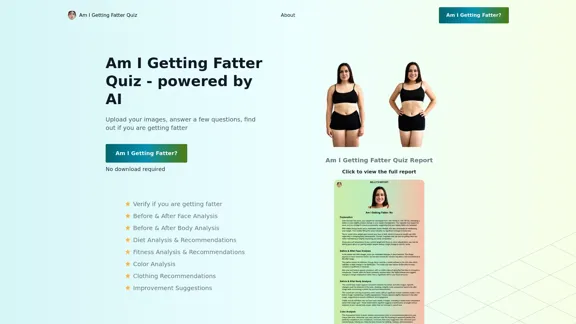
Introduction
Feature
-
AI-powered analysis
- Before & After Face Analysis
- Before & After Body Analysis
- Diet Analysis & Recommendations
- Fitness Analysis & Recommendations
- Color Analysis
- Clothing Recommendations
- Improvement Suggestions
-
User-friendly process
Step Description 1 Upload images (selfie, before, and after photos) 2 Complete the quiz 3 AI processes the information 4 Receive personalized report -
Comprehensive questionnaire
- Weight changes over 5 years
- Appetite and eating habits
- Energy levels and exercise routines
- Clothing fit
- Physical appearance changes
- Lifestyle factors
-
Privacy protection
- No account required
- No personal information stored
- Report sent via email within 2-3 minutes
-
Instant results
- Real-time processing
- Report displayed on-screen and emailed
How to Use?
- Be honest when answering the quiz questions for the most accurate results.
- Upload clear, well-lit photos for better AI analysis.
- Use recent photos for the "after" image to get the most up-to-date assessment.
- Consider taking the quiz periodically to track changes over time.
- Use the recommendations provided in the report as a starting point for lifestyle changes.
FAQ
What is the Am I Getting Fatter Quiz?
It's an AI-powered tool that analyzes your photos and quiz answers to determine if you're gaining weight and provides personalized health recommendations.
How does the Am I Getting Fatter Quiz work?
Users upload photos, answer a series of questions about their lifestyle and health, and receive an AI-generated report with analysis and recommendations.
What's included in the Am I Getting Fatter Quiz Report?
The report includes analysis of your current weight status, body composition changes, diet and exercise habits, sleep patterns, and lifestyle factors affecting your weight.
How much does the Am I Getting Fatter Quiz report cost?
The report costs $29 USD.
How will I receive my Am I Getting Fatter Quiz report?
The report is displayed on-screen immediately after completion and sent to your email within 2-3 minutes.
Price
The Am I Getting Fatter Quiz report costs $29 USD.
The price is for reference only, please refer to the latest official data for actual information.
Evaluation
-
The Am I Getting Fatter Quiz offers a unique approach to weight assessment by combining AI image analysis with a comprehensive lifestyle questionnaire. This holistic approach can provide valuable insights for users concerned about their weight.
-
The quiz's privacy measures, such as not requiring an account and not storing personal information, are commendable in an era of increasing data privacy concerns.
-
The $29 price point may be a barrier for some users, especially considering that the service is primarily based on self-reported information and photo analysis. Some users might prefer free or lower-cost alternatives for weight tracking.
-
While the AI-powered analysis is impressive, it's important to note that this tool should not replace professional medical advice. The website could benefit from more prominent disclaimers about the limitations of its analysis.
-
The comprehensive nature of the questionnaire is a strong point, covering various aspects of lifestyle and health. However, the accuracy of the results heavily depends on the user's honesty and self-awareness when answering questions.
-
The instant results and email delivery are convenient features that cater to users seeking immediate feedback. However, the 2-3 minute processing time for email delivery seems inconsistent with the claim of "real-time" processing.
Latest Traffic Insights
Monthly Visits
1.25 K
Bounce Rate
42.82%
Pages Per Visit
1.06
Time on Site(s)
0.00
Global Rank
12849029
Country Rank
-
Recent Visits
Traffic Sources
- Social Media:2.84%
- Paid Referrals:0.93%
- Email:0.28%
- Referrals:12.82%
- Search Engines:47.78%
- Direct:34.48%
Related Websites
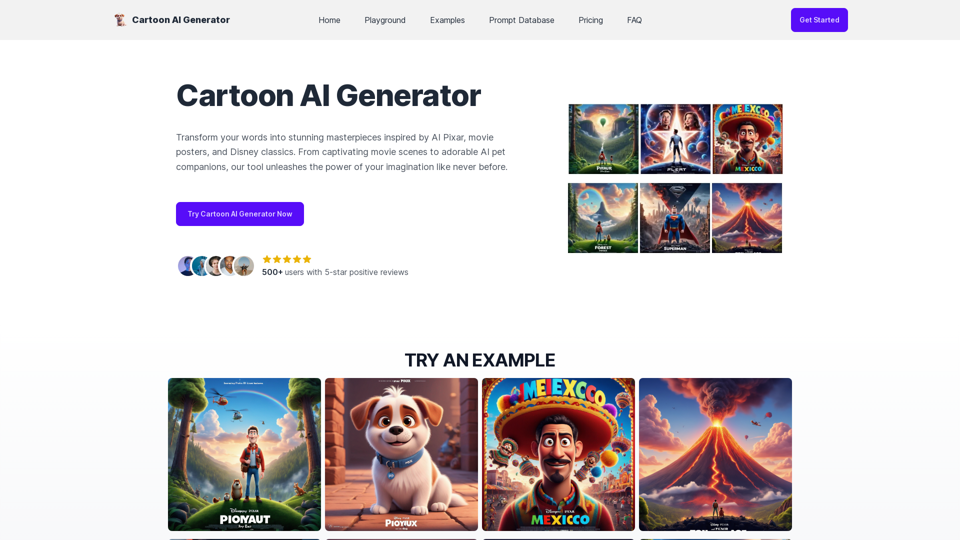
Create Stunning Disney-Style Posters with Our Cartoon AI Generator
Create Stunning Disney-Style Posters with Our Cartoon AI GeneratorCreate stunning Disney Pixar movie posters effortlessly with AI technology. pixar ai generator allows you to generate professional pixar&disney posters with ease.
0

Vmake AI - All-In-One E-commerce Creative Solutions
Vmake AI - All-In-One E-commerce Creative SolutionsVmake is an online image and video editing platform that simplifies the process of creating product photos and social media content.
2.22 M
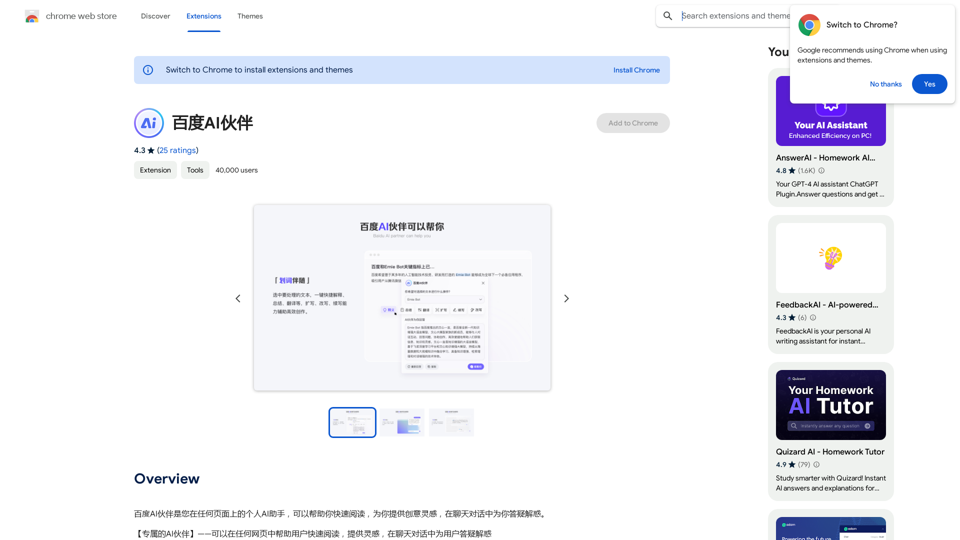
Baidu AI Partner is your personal AI assistant on any page, helping you read quickly, providing creative inspiration, and answering your questions in chat conversations.
193.90 M
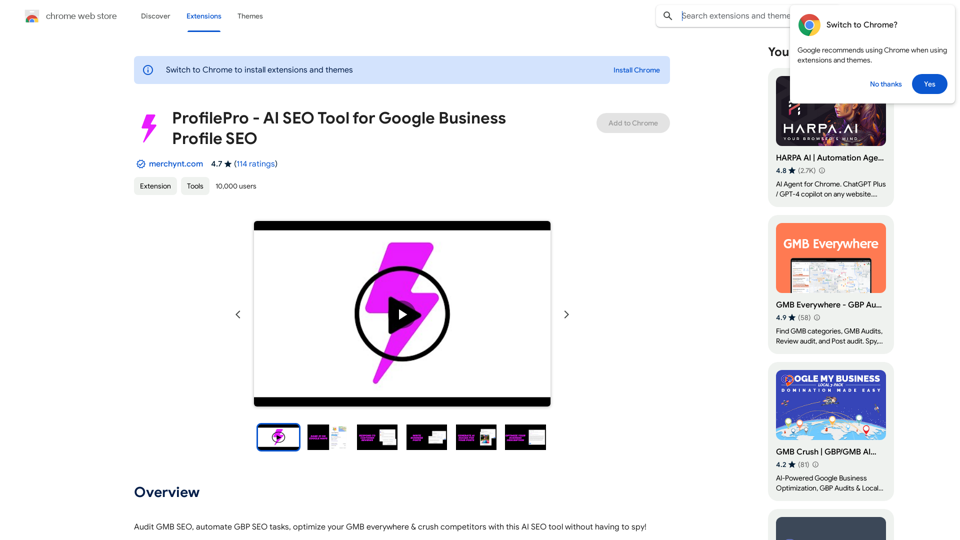
ProfilePro - AI SEO Tool for Google Business Profile SEO
ProfilePro - AI SEO Tool for Google Business Profile SEOAudit Google My Business SEO, automate Google Business Profile SEO tasks, optimize your Google My Business everywhere and outperform competitors with this AI SEO tool without having to spy!
193.90 M
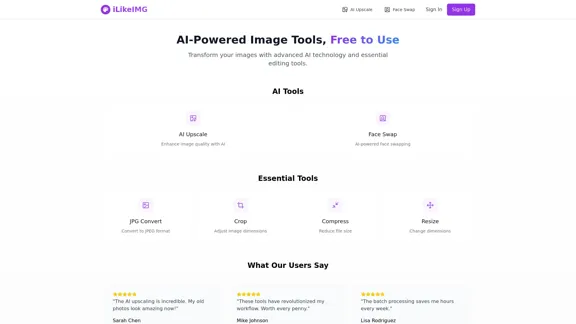
ilikeimg - AI-Powered Image Tools | Free Online Photo Editor
ilikeimg - AI-Powered Image Tools | Free Online Photo EditorFree online tools to convert, crop, compress, resize, and enhance your images. No registration required for basic features.
0
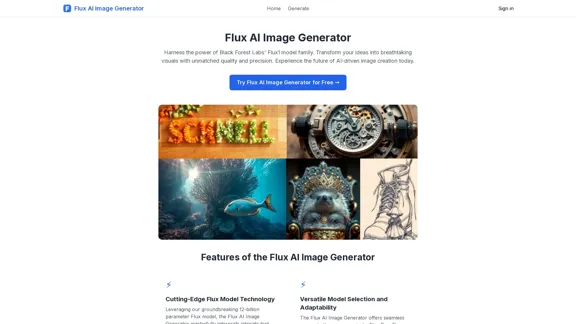
FluxImage | Free Flux AI Image Generator with Flux.1 Models
FluxImage | Free Flux AI Image Generator with Flux.1 ModelsFlux AI is a state-of-the-art text-to-image Flux.1 AI model created by Black Forest Labs. It includes Flux.1 Pro, Flux.1 Dev, and Flux.1 Schnell versions.
0

Opulli | AI Fashion Model Platform for Clothing Brands
Opulli | AI Fashion Model Platform for Clothing BrandsCreate captivating AI-generated fashion models, cutting photoshoot costs dramatically. Enhance audience engagement, accelerate market debut, and lead fashion trends with unparalleled speed and precision.
0
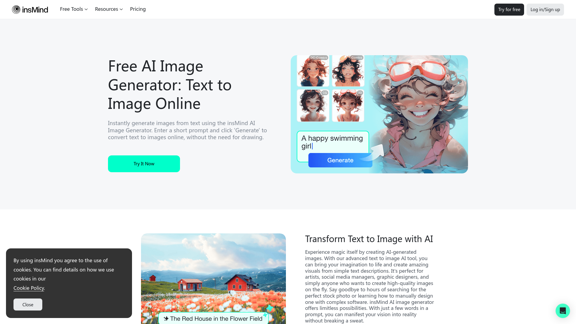
100% Free AI Image Generator: Text to Image Online | insMind
100% Free AI Image Generator: Text to Image Online | insMindLooking for a free AI image generator from text? Create stunning images with a simple text prompt using the most advanced AI text-to-image generator.
1.77 M